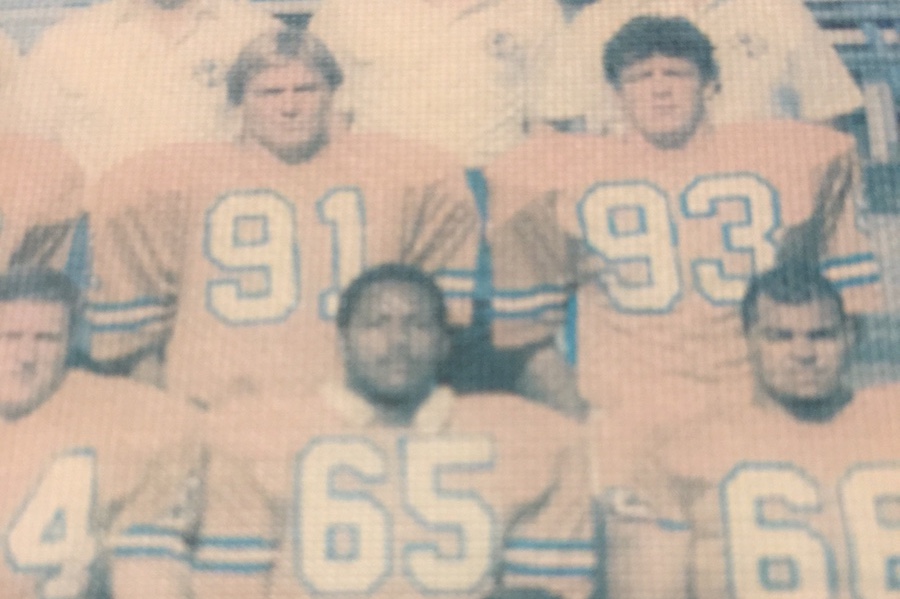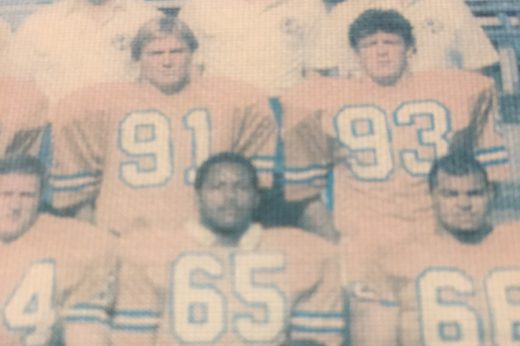Inspired by NFL Teammate, Aethlon Seeks Diagnostic for Brain Injuries

Just as the NFL marketing machine is stoking the build-up to Super Bowl LI, a San Diego diagnostic company headed by a former Denver Broncos player has unveiled plans for a new clinical study of traumatic brain injuries among retired NFL players.
Exosome Sciences, a subsidiary of San Diego’s Aethlon Medical (NASDAQ: AEMD), said today it is supporting research that could validate a potential biomarker for the type of neurodegenerative disease that shadows many football players as they grow older. The disease, known as chronic traumatic encephalopathy (CTE), typically begins with memory loss, difficulty concentrating, and mood swings. Like Alzheimer’s, it can develop into progressive dementia.
Aethlon CEO James Joyce, a former player for the Denver Broncos (he is number 93 in 1984 photo above), said he was inspired by the death of Tom McHale, a former NFL lineman and teammate from his Maryland hometown. After McHale’s death at age 45 in 2009, Boston University scientists determined that McHale had suffered from CTE.
Currently, CTE can only be diagnosed after death, by examining a person’s brain. Joyce wants to develop a blood test that can be used to diagnose CTE while a person is still alive.
In an interview (January 30, 2017), Joyce said, “We were inspired by the death of a former teammate, and there are certain players out there who I hear from because they know I’m working in this area, and they are really struggling with cognitive skills.”
Joyce declined to quantify how much support Aethlon and Exosome are providing for the research, saying only that the company agreed to analyze samples for the biomarker in blood or urine. As a microcap with a market valuation of only $30 million, Aethlon has relatively few resources of its own to fund the effort. But Joyce suggested there might be a promotional aspect to the initiative, saying he “wouldn’t be surprised” if others join in to help support the work.
In a statement today, Aethlon said it plans to “conduct a series of activities to raise awareness of the current study plans among prospective participants” in the week leading up to Super Bowl LI in Houston.
In the first NIH-funded study of CTE, scientists at Boston University reported that repetitive impact trauma can trigger a cascade of events in some individuals that leads to symptoms of neural degeneration. In Congressional testimony in 2014, Boston University’s Robert Stern testified that the hallmark feature of CTE is the buildup of an abnormal protein called tau.
In late 2015, the NIH said it would provide $16 million to fund additional CTE studies over the next seven years to find a way to diagnose CTE in living patients. The multi-center, longitudinal study intends to enroll a variety of patients to undergo extensive physical exams, PET imaging, MRI scans, blood work, and other tests with the potential to detect changes in the brain associated with CTE.
Aethlon’s Joyce said the company made a decision to support a specific study of the tau protein as a potential biomarker for CTE “in parallel” with the broader NIH study. The principal investigator of the study is Kendall Van Keuren-Jensen of the Phoenix, AZ-based Translational Genomics Research Institute’s Center for Noninvasive Diagnostics.
Joyce said Jensen hopes to enroll up to 200 NFL football players in the study.
If the follow-on study can validate the tau protein as a biomarker, and if it can be isolated in a blood sample, Joyce said it might be possible for Exosome Sciences to develop a simple blood test for diagnosing CTE.
But that’s a lot of ifs.
And even if it all can be accomplished, there is still no cure or even a treatment for CTE—and that poses a deeper and potentially more troubling question: Would you want to undergo a diagnostic test for CTE if you knew there was no cure?
(39)



